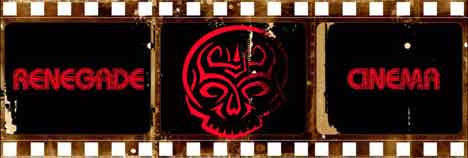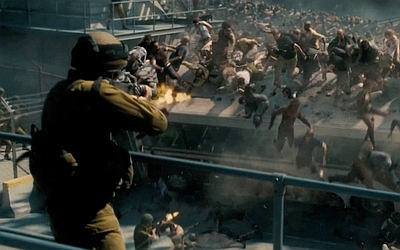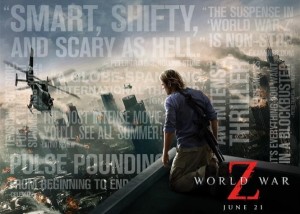The intent of this column most Tuesdays will be to compare and contrast two different entertainment properties (film, TV, books, what have you), one of which has attained blockbuster status or a major pop culture following (numbers), the other which may be lesser known but still worthy of our consideration (inspiration) in an effort to highlight the strengths of each. However, some weeks a property may provide enough fodder to sustain both sides of that discussion. That’s the way it is this week with the recently released World War Z. Shameless plug: read my Renegade Review here. My review is pretty much spoiler free, but for numerical and inspirational purposes, be warned that this column will contain SPOILERS…so if you haven’t seen the film yet and are planning to, please feel free to bookmark for later.
The Numbers
World War Z has become the little (okay, maybe not so little) zombie movie that could. Many inside Hollywood as well as those looking on from afar predicted a dud for various reasons. The first and foremost was the well documented strenuous circumstances surrounding the film and entire rewrite/reshoot of the third act, taking the finale from a drag down, knock out zombie battle in Russia to suspenseful roam through the quiet halls of a World Health Organization laboratory in Wales. It has been reported that 30-40 minutes of the tail end of the movie was rewritten/reshot to maintain the character-driven focus of the first two acts. (This will be further discussed under Inspiration below). This big mishmash of ideas (four different main writers are credited on WWZ; imagine being a continuity consultant for that) led many to believe that the final product would be a disjointed, veritable mess.
Another point of discontent was the way Max Brooks’ popular 2006 novel of the same name was being adapted. Fans of the book spoke up in internet forums everywhere decrying what they perceived would be a 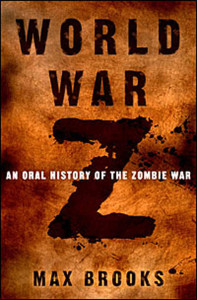 shift from the original narrative to a starring vehicle for Mr. Pitt, one of the founders of Plan B Entertainment, the studio which purchased the novel’s screen rights in 2007. I will admit to being a big fan of the source material and, as such, harbored the same concerns. And these concerns weren’t unfounded; if you’ve read the novel then you know a direct interpretation of the proceedings depicted within would be impossible to do even with a three hour movie. Of course World War Z: The Movie varies greatly from Brooks’ work but nothing short of an epic pay cable series adaptation could have properly transferred printed word to the screen. And even then there would have been changes to fit adaptive considerations; let’s not pretend any translation from book to film would be verbatim.
shift from the original narrative to a starring vehicle for Mr. Pitt, one of the founders of Plan B Entertainment, the studio which purchased the novel’s screen rights in 2007. I will admit to being a big fan of the source material and, as such, harbored the same concerns. And these concerns weren’t unfounded; if you’ve read the novel then you know a direct interpretation of the proceedings depicted within would be impossible to do even with a three hour movie. Of course World War Z: The Movie varies greatly from Brooks’ work but nothing short of an epic pay cable series adaptation could have properly transferred printed word to the screen. And even then there would have been changes to fit adaptive considerations; let’s not pretend any translation from book to film would be verbatim.
Regardless of this and many other things (such as reports of director Marc Forster and lead Brad Pitt not talking on set due to a myriad of differences, which may be just a harsh rumor), many liked what they saw, with mostly favorable critical reviews and a worldwide opening weekend take of just short of $112M USD. Domestically it is the biggest opening of Pitt’s career after the $50.3M USD opening of Mr. and Mrs. Smith in 2005. There’s still some way to go before recouping all expenses (approximately $200M USD factoring in marketing?) but the Hollywood Reporter is, well, reporting that Paramount and Pitt are already eyeing a sequel or perhaps even some full-blown franchise possibilities (the adaptation was at one time conceived as a trilogy before being reduced to the scope of this standalone yet somewhat open-ended effort). I liked the film and its lead well enough to see where this may go next, although sequels/franchising may be a little difficult as World War Z is a decent tale on its own without much need for further embellishment. Still, the proof is in the numerical pudding and Paramount along with Pitt believes that revisiting this world along with character Gerry Lane is a foregone conclusion. Pitt likely created simultaneous enthusiasm and ire with comments at the film’s Moscow premiere, saying “There is enough to mine from the book. We could barely get a fraction of the book in. So we’ll see. We’ll see.”
The Inspiration
Pitt’s comments may give some detractors heartburn, but for those of us that enjoyed World War Z, there’s a lot of positivity to note here. The film’s biggest source of inspiration is that it is above-average in the intelligence department. That’s not to say we’re witnessing Mensa levels of accomplishment committed to zombie films, but there’s more to work with than most summer thrillers. Although some clues are more obvious than others, World War Z proves that you don’t necessarily have to check your brain at the door to have a good time at the movies when it’s getting warmer outside. My favorite moment in the film comes early on as Gerry and family ascend a stairwell to reach the rooftop of a tenement in Jersey, where a helicopter extraction (hopefully) awaits. Gerry doesn’t get bit but some infected blood leaks into his mouth 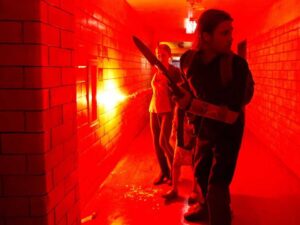 during an encounter. While his family looks on in astonishment, Gerry runs out to the rooftop after escaping narrow death and, instead of running to them, rushes past and steps directly onto the ledge, almost hovering there as he counts “one-one-thousand, two-one-thousand…” knowing that it takes roughly 12 seconds for the “zombie” virus to manifest itself. It’s done in a swift and shocking way that I was completely caught off guard, wondering “What the $@#& is he doing?” until realization sunk in. The movie didn’t need to spell it out for me, but rather let me work my own way to the fact that Gerry was going to hurl himself over the edge if he felt himself turning. (Of course he wasn’t going to turn; after all this is the first act of a Brad Pitt flick.) I appreciated that the powers that be didn’t dumb it down, and this and other moments within made World War Z more enjoyable than it would have been had every circumstance been spray painted all over the film stock.
during an encounter. While his family looks on in astonishment, Gerry runs out to the rooftop after escaping narrow death and, instead of running to them, rushes past and steps directly onto the ledge, almost hovering there as he counts “one-one-thousand, two-one-thousand…” knowing that it takes roughly 12 seconds for the “zombie” virus to manifest itself. It’s done in a swift and shocking way that I was completely caught off guard, wondering “What the $@#& is he doing?” until realization sunk in. The movie didn’t need to spell it out for me, but rather let me work my own way to the fact that Gerry was going to hurl himself over the edge if he felt himself turning. (Of course he wasn’t going to turn; after all this is the first act of a Brad Pitt flick.) I appreciated that the powers that be didn’t dumb it down, and this and other moments within made World War Z more enjoyable than it would have been had every circumstance been spray painted all over the film stock.
The next big area of inspiration for this Renegade Writer was the lack of blood and guts on display. Of course, this is where some of our brethren come out of the woodwork to scream about the atrocities of making a film largely bloodless to secure a PG-13 rating and thus make more money. Sometimes I agree with this stance but let’s be honest, we didn’t get everything we wanted out of an R-Rated Prometheus either, so the door swings both ways on this argument. Here, the lack of blood amped up the suspense and creepiness factors tenfold. I simply imagine the scene aboard the commercial airliner leaving Jerusalem being less harrowing if we had been shown a bunch of carnage behind that curtain that separated passenger classes. Rather, the horrified passenger looks and facial reactions to what was likely happening was just enough to convey the situation and make the viewer gulp a little bit. This was a fantastic sequence that, just like many others, actually would have been weakened if saturated by fantastical gore. Money-making move or not, I applaud the decision if for nothing else than my heightened enjoyment based on the fact that I could pay attention to other important facets of the film rather than feeling I was watching a big screen wannabe version of The Walking Dead (a show I also happen to like – mostly).
Finally, inspiration comes in the form of characterization in World War Z. It’s true that there’s not a ton of character development per say, but as I’ve stated in my review this movie is a snapshot of the days immediately following an apocalyptic scenario. Therefore, significant development over a 72-96 hour time  span would likely be somewhat forced anyway. Rather, we have a man with a family who used to work in dangerous areas for the U.N. As long as he’s out there looking for patient zero, his family gets to sleep and eat in relative safety. Stakes defined, protagonist motivation established. Pitt still gets to show plenty of emotion as Gerry and the rest of the cast range from serviceable to exceptional (there’s no backstory on Gerry’s new soldier pal that he picked up in Jerusalem, but she kicks ass). This ties back into the numbers part of this exercise, as people scratch their heads that a film with so many production woes could go on to be a winner. I posit that it’s exactly because of the third act redo. Rather than eschew character driven motives and make Pitt’s Gerry a warrior type hacking and slashing his way out of a field of the undead in Russia, the film smartly reduces the scope as it approaches its conclusion. This lets us peek into the (relative) psyche of the undead, the way they move, and their purpose (more enthusiastic transmitters of the virus than brain eaters). The haunted house setting of the W.H.O. lab is simply more believable (or as believable as possible given the film’s subject matter) than some type of all-out war set piece, letting the characters go to stealth mode and use their brains rather than manufactured (read: unrealistic) brawn to effort a solution. This heightens rather than diminishes the grandiosity of the film’s closing moments and what character efforts have borne – not a cure, necessarily, but a way to start working towards a final resolution.
span would likely be somewhat forced anyway. Rather, we have a man with a family who used to work in dangerous areas for the U.N. As long as he’s out there looking for patient zero, his family gets to sleep and eat in relative safety. Stakes defined, protagonist motivation established. Pitt still gets to show plenty of emotion as Gerry and the rest of the cast range from serviceable to exceptional (there’s no backstory on Gerry’s new soldier pal that he picked up in Jerusalem, but she kicks ass). This ties back into the numbers part of this exercise, as people scratch their heads that a film with so many production woes could go on to be a winner. I posit that it’s exactly because of the third act redo. Rather than eschew character driven motives and make Pitt’s Gerry a warrior type hacking and slashing his way out of a field of the undead in Russia, the film smartly reduces the scope as it approaches its conclusion. This lets us peek into the (relative) psyche of the undead, the way they move, and their purpose (more enthusiastic transmitters of the virus than brain eaters). The haunted house setting of the W.H.O. lab is simply more believable (or as believable as possible given the film’s subject matter) than some type of all-out war set piece, letting the characters go to stealth mode and use their brains rather than manufactured (read: unrealistic) brawn to effort a solution. This heightens rather than diminishes the grandiosity of the film’s closing moments and what character efforts have borne – not a cure, necessarily, but a way to start working towards a final resolution.
Give World War Z a chance if you’re on the fence; it doesn’t reframe the genre, but it’s also far from disappointing. Thanks for reading, and be sure to join again next week; we’re gonna talk about fast cars.
